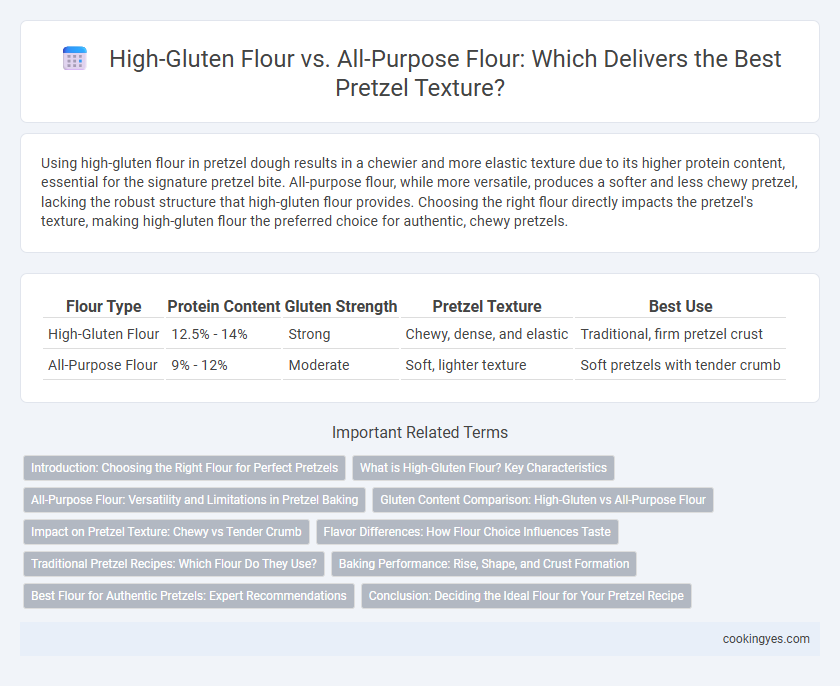Using high-gluten flour in pretzel dough results in a chewier and more elastic texture due to its higher protein content, essential for the signature pretzel bite. All-purpose flour, while more versatile, produces a softer and less chewy pretzel, lacking the robust structure that high-gluten flour provides. Choosing the right flour directly impacts the pretzel's texture, making high-gluten flour the preferred choice for authentic, chewy pretzels.
Table of Comparison
| Flour Type | Protein Content | Gluten Strength | Pretzel Texture | Best Use |
|---|---|---|---|---|
| High-Gluten Flour | 12.5% - 14% | Strong | Chewy, dense, and elastic | Traditional, firm pretzel crust |
| All-Purpose Flour | 9% - 12% | Moderate | Soft, lighter texture | Soft pretzels with tender crumb |
Introduction: Choosing the Right Flour for Perfect Pretzels
High-gluten flour, containing 12-14% protein, develops a stronger, chewier pretzel texture than all-purpose flour, which has 10-12% protein. The increased gluten formation in high-gluten flour creates the characteristic dense, elastic crumb and glossy crust essential to traditional pretzels. Using all-purpose flour results in a softer, less structured pretzel with a more tender bite, making high-gluten flour ideal for authentic pretzel recipes.
What is High-Gluten Flour? Key Characteristics
High-gluten flour, derived from hard wheat varieties, contains 13-14% protein, significantly higher than the 10-12% in all-purpose flour, providing increased gluten strength and elasticity essential for chewy pretzel crusts. Its robust gluten network traps gas effectively during fermentation, resulting in a denser crumb and characteristic pretzel bite. This flour's moisture absorption and higher gluten content create the distinctive texture and structure preferred in traditional pretzel recipes.
All-Purpose Flour: Versatility and Limitations in Pretzel Baking
All-purpose flour offers versatility in pretzel baking but lacks the gluten strength required for the traditional chewy texture of authentic pretzels. Its moderate protein content, typically around 10-12%, results in a softer crumb and less elasticity compared to high-gluten flour, which contains 12-14% protein. As a result, pretzels made with all-purpose flour may have a lighter bite and reduced structure, making it suitable for softer, less dense pretzel varieties.
Gluten Content Comparison: High-Gluten vs All-Purpose Flour
High-gluten flour contains approximately 12-14% protein, significantly higher than the 10-12% protein found in all-purpose flour, which impacts pretzel texture by providing greater elasticity and chewiness. This increased gluten content allows pretzels to develop a denser, more structured crumb and a characteristic chewy bite. All-purpose flour results in a softer, less resilient texture, making high-gluten flour the preferred choice for traditional pretzel recipes.
Impact on Pretzel Texture: Chewy vs Tender Crumb
High-gluten flour contains higher protein content, which develops more gluten strands, resulting in a chewier pretzel texture essential for traditional soft pretzels. In contrast, all-purpose flour has moderate protein levels, producing a more tender crumb and less elasticity, ideal for softer, less dense pretzels. The choice between these flours directly influences the pretzel's bite, with high-gluten flour yielding a firm chew and all-purpose flour creating a lighter, crumbly interior.
Flavor Differences: How Flour Choice Influences Taste
High-gluten flour imparts a chewier, more robust texture with a slightly nutty flavor ideal for traditional pretzels, enhancing the savory notes and giving a satisfying bite. All-purpose flour produces a softer pretzel with a milder taste, allowing toppings and dough conditioners to play a larger role in flavor development. Choosing high-gluten flour elevates the authenticity and complexity of pretzel flavor, while all-purpose flour offers versatility and a lighter taste profile.
Traditional Pretzel Recipes: Which Flour Do They Use?
Traditional pretzel recipes typically use high-gluten flour to achieve the characteristic chewy texture and dense crumb associated with authentic pretzels. High-gluten flour contains a higher protein content, usually around 12-14%, which enhances gluten development and elasticity, essential for the pretzel's signature crust and bite. In contrast, all-purpose flour, with its lower protein content of approximately 10-12%, produces a softer and less chewy pretzel, making high-gluten flour the preferred choice in classic pretzel baking.
Baking Performance: Rise, Shape, and Crust Formation
High-gluten flour enhances pretzel texture by providing superior elasticity and a stronger gluten network, promoting optimal rise and shape retention during baking. Compared to all-purpose flour, it supports a chewier interior and a crisper, well-defined crust essential for authentic pretzels. The higher protein content in high-gluten flour directly influences crust caramelization and the characteristic glossy finish from the alkaline bath.
Best Flour for Authentic Pretzels: Expert Recommendations
High-gluten flour is the best flour for authentic pretzels because its increased protein content creates a chewier, more elastic dough that mimics traditional pretzel texture. All-purpose flour, with lower protein, produces softer pretzels with less structure, making it less ideal for achieving the classic dense, crisp crust. Experts recommend using high-gluten flour for pretzels to ensure the optimal balance of chewiness and crustiness that defines genuine pretzel quality.
Conclusion: Deciding the Ideal Flour for Your Pretzel Recipe
High-gluten flour produces pretzels with a chewier and more elastic texture due to its higher protein content, which strengthens gluten development. All-purpose flour yields a softer and less dense pretzel, suitable for a lighter bite but with less structure. Choosing high-gluten flour is ideal for authentic, traditional pretzels that require a robust texture, while all-purpose flour works well for softer, more versatile variations.
High-Gluten Flour vs All-Purpose Flour for Pretzel Texture Infographic

 cookingyes.com
cookingyes.com